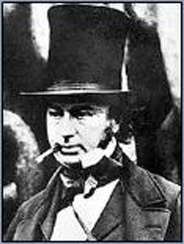
Isambard Kingdom Brunel, son of the distinguished engineer Sir Marc Isambard Brunel, was both an extravagant and prolific engineer in his own right. By the time of his death at the age of 53, he had overseen the construction of 25 railway lines, hundreds of bridges including five suspension bridges, eight pier and dock systems, three major ships, and a prefabricated hospital.
Born in 1806 in Portsmouth, England, Isambard was sent to school at Caen in Normandy. This was followed by the Lycee Henri Quatre in Paris, noted for its teaching of mathematics. Upon returning to England responsibility was thrust upon the 19-year-old, for his father named him chief engineer of the Thames Tunnel project. When part of the tunnel collapsed under the weight of the Thames riverbed, Isambard was nearly killed, and spent a year in Clifton recuperating. It was in Clifton that the younger Brunel made his own mark in engineering, for his design for the Clifton Suspension Bridge was accepted in the face of strong opposition from none other than the venerable Thomas Telford.
Most prominent in his early work was the Great Western Railway connecting London and Bristol. The railway was a clever achievement that avoided steep gradients, an important factor given the horsepower limitations of locomotives. Brunel achieved this by means of a network of low-rise bridges and tunnels, the two-mile long Box Tunnel being the longest of its day. Brunel's foray into railroads was not without controversy, for his eccentric seven-foot gauge hindered the networking of railroad lines, and his "atmospheric system," wherein trains drew their power from air pumped into a pipe laid alongside the rails, became an expensive and foolhardy adventure for his investors. Brunel's penchant for the extravagant was most evident at a meeting of the Great Western Railway board of directors around 1934. The board was concerned with the proposed record length of the main line. Brunel proposed the contrary view, stating, "Why not make it longer, and have a steamboat go from Bristol to New York and call it the Great Western? " In light of the fact that no steamship as of 1834 could carry enough coal to make the transatlantic journey, Brunel rallied enough support for his vision and in 1838 the SS Great Western pulled into New York Harbor in record time — so much for conventional wisdom.
The SS Great Western's success can be attributed to Brunel's realization that the resistance of a vessel in water does not increase in proportion to its tonnage. Therefore, by building bigger ships he could effectively increase their range. Brunel applied the principle to the SS Great Britain (1843) and SS Great Eastern (1858) respectively. The Great Britain was the largest ship in the world. Built of iron to support its massive frame, it was the first to cross the Atlantic using screw propulsion. Amazingly, the SS Great Eastern was twice the length (692 feet) of the Great Britain and displaced an unprecedented 32,000 tons. It was the first ship to employ a double iron hull design and strategic compartmentalization, and utilized both paddle and screw propulsion. In many respects the SS Great Eastern, like her inventor, was too big for her time.
Although blessed with the cutting edge technologies of the day, the ship bankrupted its investors and arguably contributed to the untimely death of Brunel himself. But the extravagance of Brunel's creations set standards for the next generation of engineers to follow, and for this above all the great innovator is remembered. As for awards, I.K. Brunel was elected Fellow of the Royal Society in 1830, received a Doctorate of Civil Law from Oxford, and the Chevalier of the Legion d'Honneur. He had been an active member/leader in ICE on the ICE Council 1834-41, 1845-49, and served as ICE Vice President 1850-59. Brunel died on Sept. 15, 1859, the year he completed his design for the Royal Albert Bridge at Saltash over the River Tamar. The portals to that bridge bear the engineer's name as an enduring tribute to him.

